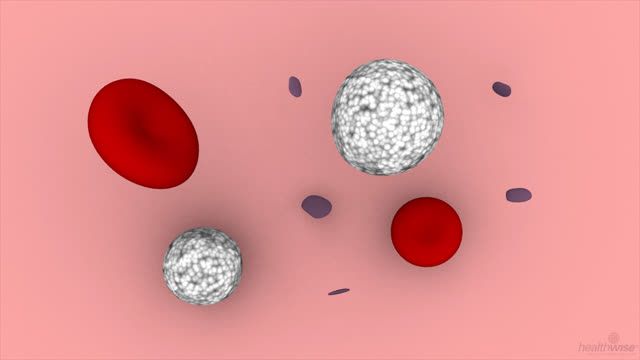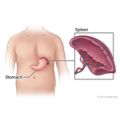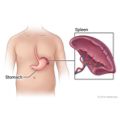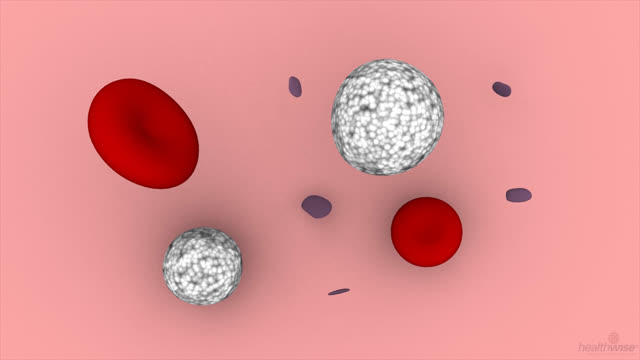Complete Blood Count (CBC)
Test Overview
A complete blood count (CBC) gives important information about the kinds and numbers of cells in the blood, especially red blood cells, Opens dialog, white blood cells, Opens dialog, and platelets, Opens dialog. A CBC helps your doctor check any symptoms that you may have, such as weakness, fatigue, or bruising. A CBC also helps him or her diagnose conditions, such as anemia, Opens dialog, infection, and many other disorders.
A CBC test usually includes:
- White blood cell (WBC, leukocyte) count.
White blood cells protect the body against infection. If an infection develops, white blood cells attack and destroy the bacteria, virus, or other organism causing it. White blood cells are bigger than red blood cells but fewer in number. When a person has a bacterial infection, the number of white cells rises very quickly. The number of white blood cells is sometimes used to find an infection or to see how the body is dealing with cancer treatment.
- White blood cell types (WBC differential).
The major types of white blood cells are neutrophils, Opens dialog, lymphocytes, monocytes, eosinophils, and basophils. Immature neutrophils, called band neutrophils, are also part of this test. Each type of cell plays a different role in protecting the body. The numbers of each one of these types of white blood cells give important information about the immune system, Opens dialog. Too many or too few of the different types of white blood cells can help find an infection, an allergic, Opens dialog or toxic reaction to medicines or chemicals, and many conditions, such as leukemia, Opens dialog.
- Red blood cell (RBC) count.
Red blood cells carry oxygen from the lungs to the rest of the body. They also carry carbon dioxide back to the lungs so it can be exhaled. If the RBC count is low (anemia), the body may not be getting the oxygen it needs. If the count is too high (a condition called polycythemia), there's a chance that the red blood cells will clump together and block tiny blood vessels (capillaries). This also makes it hard for your red blood cells to carry oxygen.
- Hematocrit (HCT, packed cell volume, PCV).
This test measures the amount of space (volume) red blood cells take up in the blood. The value is given as a percentage of red blood cells in a volume of blood. For example, a hematocrit of 38 means that 38% of the blood's volume is made of red blood cells. Hematocrit and hemoglobin, Opens dialog values are the two major tests that show if anemia or polycythemia is present.
- Hemoglobin (Hgb).
The hemoglobin molecule fills up the red blood cells. It carries oxygen and gives the blood cell its red color. The hemoglobin test measures the amount of hemoglobin in blood. It's a good measure of how well the blood can carry oxygen throughout the body.
- Red blood cell indices.
There are three red blood cell indices: mean corpuscular volume (MCV), mean corpuscular hemoglobin (MCH), and mean corpuscular hemoglobin concentration (MCHC). They are measured by a machine, and their values come from other measurements in a CBC. The MCV shows the size of the red blood cells. The MCH value is the amount of hemoglobin in an average red blood cell. The MCHC measures the concentration of hemoglobin in an average red blood cell. These numbers help in the diagnosis of different types of anemia. Red cell distribution width (RDW) can also be measured. It shows if the cells are all the same or different sizes or shapes.
- Platelet (thrombocyte) count.
Platelets (thrombocytes) are the smallest type of blood cell. They are important in blood clotting. When bleeding occurs, the platelets swell, clump together, and form a sticky plug that helps stop the bleeding. If there are too few platelets, uncontrolled bleeding may be a problem. If there are too many platelets, there is a chance of a blood clot forming in a blood vessel. Also, platelets may be involved in hardening of the arteries (atherosclerosis, Opens dialog).
- Mean platelet volume (MPV).
Mean platelet volume measures the average amount (volume) of platelets. MPV is used along with platelet count to diagnose some diseases. If the platelet count is normal, the MPV can still be too high or too low.
Related Videos
A CBC may be done as part of a regular physical exam. There are many other reasons that a doctor may want this blood test, including to:
- Find the cause of symptoms such as fatigue, weakness, fever, bruising, or weight loss.
- Check for anemia.
- See how much blood has been lost if there is bleeding.
- Diagnose polycythemia, Opens dialog.
- Check for an infection.
- Diagnose diseases of the blood, such as leukemia.
- Check how the body is dealing with some types of drug or radiation treatment.
- Check how abnormal bleeding is affecting the blood cells and counts.
- Screen for high and low values before a surgery.
- See if there are too many or too few of certain types of cells. This may help find other conditions. For instance, too many eosinophils may be a sign of an allergy or asthma.
A blood count can give valuable information about the general state of your health.
When a blood sample is taken, you may feel nothing at all from the needle. Or you might feel a quick sting or pinch.
There is very little chance of having a problem from this test. When a blood sample is taken, a small bruise may form at the site.
Normal
Each lab has a different range for what's normal. Your lab report should show the range that your lab uses for each test. The normal range is just a guide. Your doctor will also look at your results based on your age, health, and other factors. A value that isn't in the normal range may still be normal for you.
Normal values for the complete blood count (CBC) tests depend on age, sex, how high above sea level you live, and the type of blood sample. Your doctor may use all the CBC values to check for a condition. For example, the red blood cell (RBC) count, hemoglobin (Hgb), and hematocrit (HCT) are the most important values needed to tell whether a person has anemia. But the red blood cell indices and the blood smear also help with the diagnosis and may show a possible cause for the anemia.
To see if the white blood cell (WBC, leukocyte) count is good and how the cells look on the smear, your doctor will look at both the number (WBC count) and the WBC differential. To see whether there are too many or too few of a certain type of cell, your doctor will look at the total count and the percentage of that particular cell. There are normal values for the total number of each type of white cell.
Pregnancy can change these blood values. Your doctor will talk with you about normal values during each trimester of your pregnancy.
Normal: | Blood cells are normal in shape, size, color, and number. |
|---|
High values
- Red blood cells (RBC).
- Conditions that cause high RBC values include smoking, exposure to carbon monoxide, long-term lung disease, kidney disease, some cancers, certain forms of heart disease, alcohol use disorder, Opens dialog, liver disease, a rare disorder of the bone marrow (polycythemia vera, Opens dialog), and a rare disorder of hemoglobin that binds oxygen tightly.
- Conditions that affect the body's water content can also cause high RBC values. These conditions include dehydration, Opens dialog, diarrhea or vomiting, excessive sweating, and the use of diuretics, Opens dialog. The lack of fluid in the body makes the RBC volume look high. This is sometimes called spurious polycythemia.
- White blood cells (WBC, leukocytes).
- Conditions that cause high WBC values include infection, inflammation, damage to body tissues (such as a heart attack, Opens dialog), severe physical or emotional stress (such as a fever, injury, or surgery), kidney failure, lupus, Opens dialog, tuberculosis (TB), Opens dialog, rheumatoid arthritis, Opens dialog, malnutrition, leukemia, Opens dialog, and diseases such as cancer.
- The use of corticosteroids, Opens dialog, underactive adrenal glands, Opens dialog, thyroid gland, Opens dialog problems, certain medicines, and removal of the spleen, Opens dialog can also cause high WBC values.
- Platelets.
- High platelet values may be seen with bleeding, iron deficiency, some diseases like cancer, or problems with the bone marrow.
Low values
- Red blood cells (RBC).
- Anemia lowers RBC values. Anemia can be caused by heavy menstrual bleeding, stomach ulcers, Opens dialog, colon cancer, Opens dialog, inflammatory bowel disease, Opens dialog, some tumors, Addison's disease, Opens dialog, thalassemia, Opens dialog, lead poisoning, Opens dialog, sickle cell disease, Opens dialog, and reactions to some chemicals and medicines. A low RBC value may also be seen if the spleen has been taken out.
- A lack of folic acid or vitamin B12 can also cause anemia, such as pernicious anemia, Opens dialog. This is a problem with absorbing vitamin B12.
- The RBC indices value and a blood smear may help find the cause of anemia.
- White blood cells (WBC, leukocytes).
- Conditions that can lower WBC values include chemotherapy, Opens dialog and reactions to other medicines, aplastic anemia, Opens dialog, viral infections, malaria, Opens dialog, alcohol use disorder, AIDS, Opens dialog, lupus, Opens dialog, and Cushing's syndrome, Opens dialog.
- A large spleen can lower the WBC count.
- Platelets.
- Low platelet values can occur in pregnancy or immune thrombocytopenic purpura (ITP), Opens dialog and other conditions that affect how platelets are made or that destroy platelets.
- A large spleen can lower the platelet count.
Current as of: April 30, 2024
Author: Ignite Healthwise, LLC Staff
Clinical Review Board
All Healthwise education is reviewed by a team that includes physicians, nurses, advanced practitioners, registered dieticians, and other healthcare professionals.
Current as of: April 30, 2024
Author: Ignite Healthwise, LLC Staff
Clinical Review Board
All Healthwise education is reviewed by a team that includes physicians, nurses, advanced practitioners, registered dieticians, and other healthcare professionals.
Topic Contents
This information does not replace the advice of a doctor. Ignite Healthwise, LLC, disclaims any warranty or liability for your use of this information. Your use of this information means that you agree to the Terms of Use. Learn how we develop our content.




















